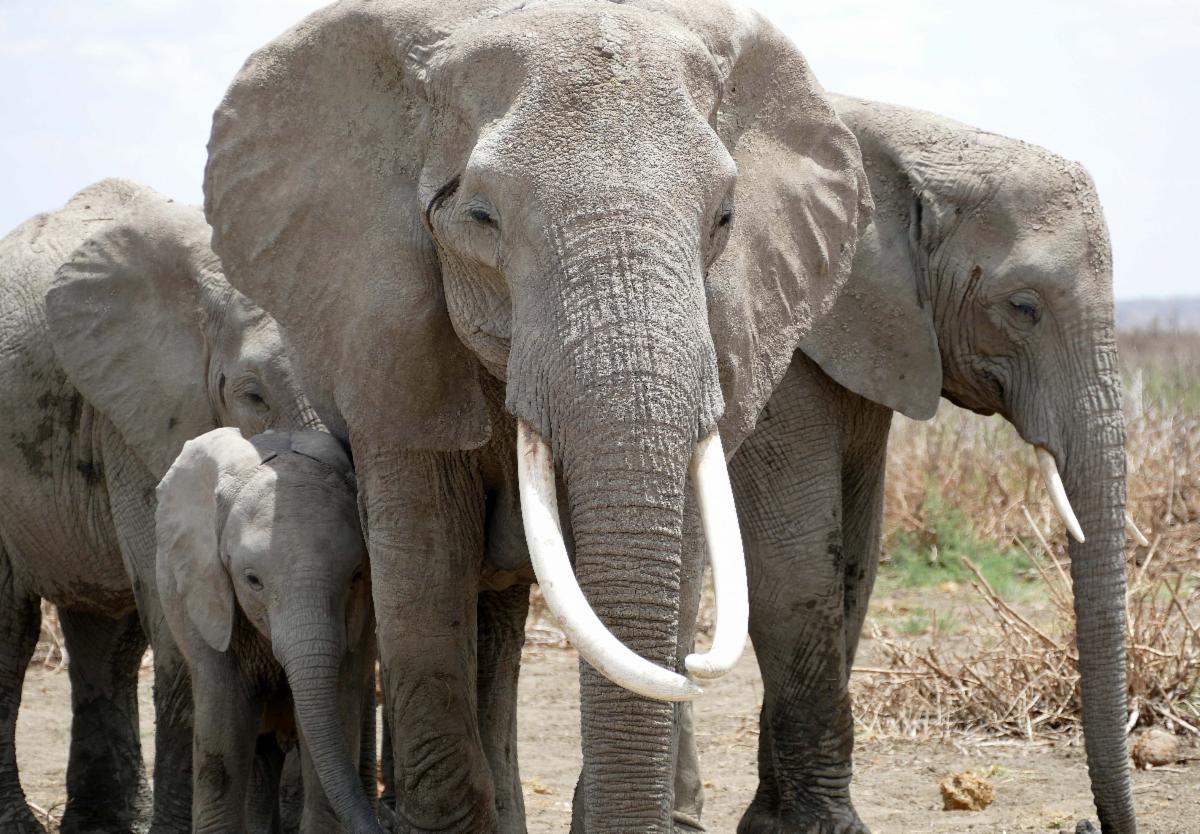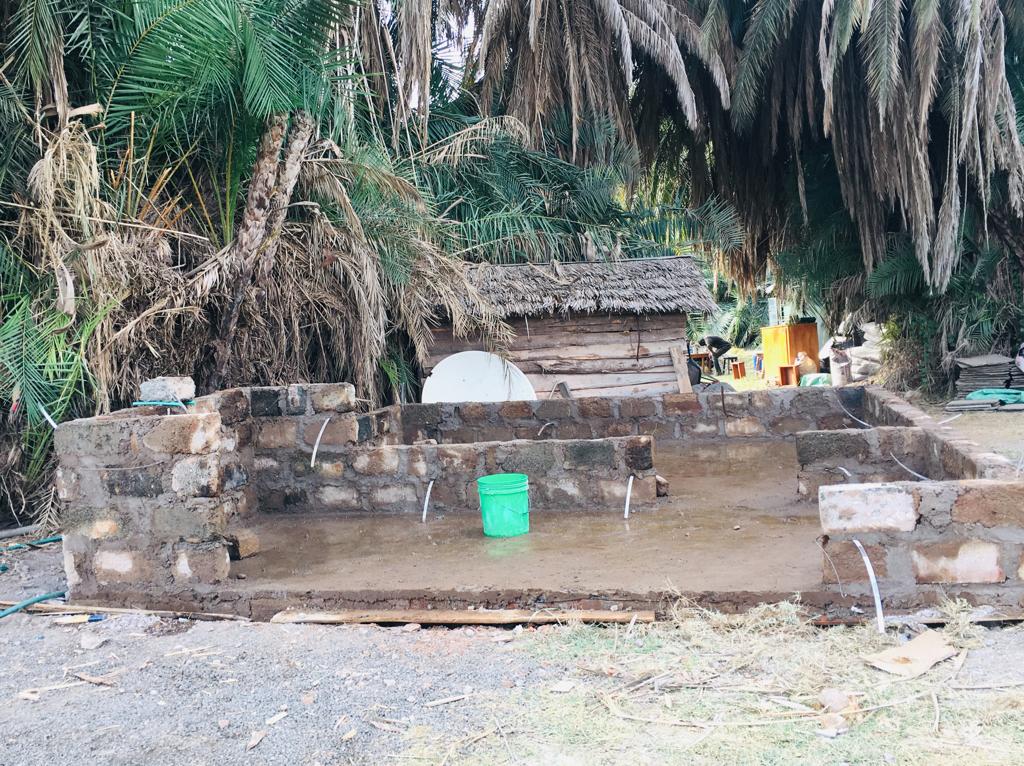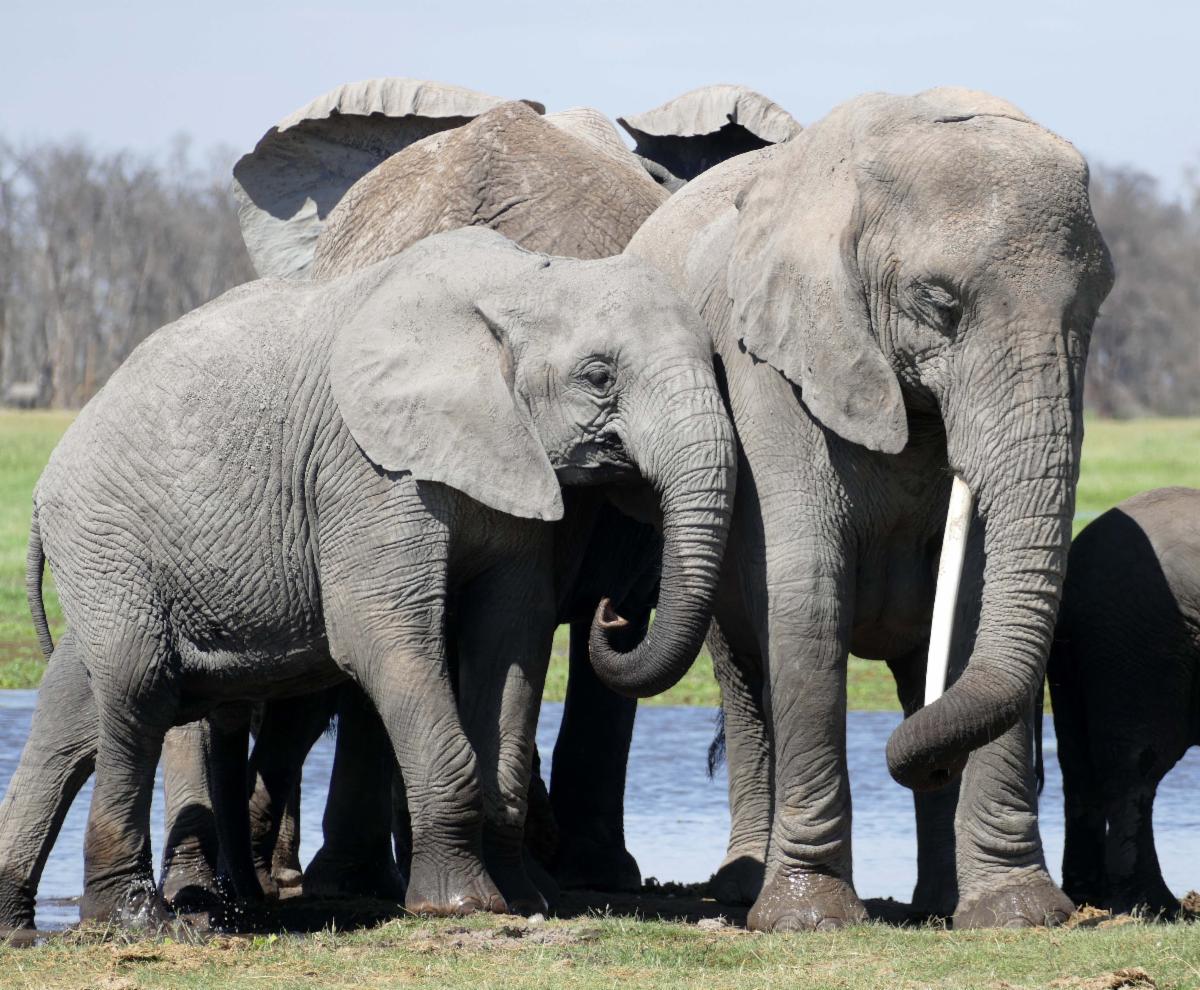
Beautiful, sweet-natured 49-year-old Keira and her calves are an important part of our research. We need your help to continue
|

Our Camp Kitchen - a new chapter
The kitchen is the heart of our camp, producing delicious food and the all-important ginger tea that keeps our team going. After 29 years of valiant service, the current structure was experiencing invasions of rats, snakes(!) and thieving baboons(!!!). For safety and hygiene reasons we are in the process of totally rebuilding, while Josephat and Hezron heroically keep feeding us and the building team.
This is a large expense for us. We would greatly appreciate donations toward the costs of a safe kitchen.
|
|
Thanking our Loyal Donors
Doug Aja
Elizabeth Barrett
Born Free Foundation
Leslie Conant
Anne & Thomas Erhart
Extraordinary Journeys
Joseph & Marie Field Family Foundation
Judie Graham-Bell
Kane Enterprises
Eleanor Knox
Leanne Lachmann
Gretchen & James Mair
Maue Kay Foundation
Mary Jane O'Loughlin
Carol Reading
Rettet die Elefanten Afrikas
Skinner Family Foundation
Strear Family Foundation
|
|
Elephant Specialists Urge End to Elephants in Captivity
In September, a conference of elephant specialists--from Kenya, Great Britain, the Netherlands, South Africa, the United States, and Zimbabwe--met in South Africa to create "policy guidelines for dealing with elephants in captivity."
The conference,
Taking the Elephant out of the Room, followed the historic ruling by CITES prohibiting wild-caught elephants from being held in captive facilities. The conference resulted in a loud and emphatic call for an end to all elephants in captivity, with attendees not only stressing welfare concerns but also pointing out that science is not furthered by studying elephants that have ceased to perform natural familial, communicative, and relational behaviors. ATE has opposed the captivity of elephants for decades, and we applaud this declaration.
There are currently 1,770 elephants worldwide in captive facilities, of which 1,491 are in zoos. Most of these are in the United States, China, Germany, and Japan. Almost a hundred zoos around the world hold a single elephant, alone and unable to perform any of the complex inter-elephant behavior that makes elephants so special. It is time for the cruel and unnatural confinement of elephants in zoos to end.
The conference was live-streamed and can be viewed at
HERE.
|
Moses on Secondment
Collaborations are key in addressing the complex problems facing ecosystems today. Amboseli is a coexistence landscape, so making sure that wildlife and people both thrive involves working together to understand everyone's needs. Sometimes collaborations with our partners involve supporting each other with training, or with resources.
For the past two months, ATE's Moses Saruni has been on secondment with the Amboseli Ecosystem Trust, working on a grant to understand how the fast-changing landscape challenges pastoralist livelihoods. He is also assisting the AET team with the various activities surrounding the all-important Amboseli Ecosystem Management Plan. Although we miss having Moses with us, this is a great opportunity for him to use his communication skills to help build sustainable conservation planning for Amboseli communities. We're proud to be able to lend his skills and give him an opportunity to work directly on issues that are important to him.
|
|
|
Moses in action, collecting community perspectives
|
|
More Collaborative Action!
In early September we welcomed back ATE collaborator Dr. Vicky Boult for a special working group. Vicky used part of the Amboseli dataset to build an individual-based model of elephant movements for her PhD. With the help of partners we explored the effects of climate change and habitat loss on the elephants for the next 100 years.
|
|
|
How do you capture decades of professional experience to make better data tools? With sticky notes, pens and lots of good debate!
|
This working group meeting was to ask partners to assess Vicky's model and whether it could be useful as a tool in Amboseli's conservation challenges. With a resounding yes, our partners from School for Field Studies, Big Life Foundation, Amboseli Ecosystem Trust, Olgulului-Ololorashi Community Rangers and the Amboseli Ecosystem Planning Consultant gave Vicky valuable insights on avenues for tool development and use. We are so grateful for their combined experience, which should help Vicky write funding applications to take her work further and we can't wait to see how this develops.
|
|
Ways to Support Us
Follow an Amboseli Family with Elatia

If you want to share our insider view of elephant lives, consider joining us to follow an elephant family for a year. We have chosen six Amboseli families for our Elatia program: the AAs, EBs, FBs, GBs, OAs, and PCs. You can choose one or all of the families to follow. Regular updates include photos and videos, and news of what is going on in the family.
To learn more about Elatia
go to
This Link.
If you have any problems, Tal has made a tutorial for signing up,
Click Here.
You can also contact her directly if you have any questions on:
**********
Name a Baby Elephant
This calf from the AA family was recently named by a donor. You could also name a calf.
Unlike our Elatia program where many people follow the same family, our naming program is a unique experience. The calf becomes "your" calf alone and the name you give forms a part of the Amboseli dataset for all time. For more information, please write to us at:
[email protected]
*********
iGive
One of the ways you can support ATE is by making your online purchases through iGive. If you sign up the Amboseli Trust for Elephants as your recipient organization we will get a small percentage of the sale. Connect with
iGive.
Give a Gift that Lasts Forever
Designate the Amboseli Trust for Elephants as a beneficiary of your will, individual retirement account, or life insurance policy. To learn more about planned giving opportunities, please contact Betsy Swart:
Tel +1-508-783-8308.
|
|
|
News from the Amboseli Trust for Elephants
July - September 2019
|
|
T
he last few months have been a busy time in the conservation world. There were many important meetings leading up to the August
meeting of the Convention in International Trade in Endangered Species of Fauna and Flora (CITES) in Switzerland. Our Executive Director Betsy Swart, who has attended almost every CITES meeting since the beginning, reports below. We are cautiously happy and optimistic about the outcome.
Many people think that CITES is a conservation convention, but it's actually a trade convention aimed at regulating trade in endangered species. Its goal is not to stop trade but to manage trade in species such as elephants, rhinos, lions and giraffes. Every two and half to three years CITES meets and those concerned with wildlife get very excited in the hope that it will solve complex conservation issues. In some cases it can have a very positive impact. However, true conservation has to take place on the ground, in the hearts and minds of people who live alongside wildlife.
In Kenya, I have seen some amazing changes in attitude over the 50 years I've lived here. There are so many young Kenyans passionate and outspoken about saving their natural heritage. Kenya banned sport hunting in 1977 and all sales of wildlife products in 1978. These bans were partly the result of Wildlife Clubs of Kenya students marching in Nairobi. Today Kenyan students and youth groups such as SUSO (Stand Up and Shout Out) are continuing that tradition and there are so many more of them now. It gives me hope.
Cynthia Moss
Director
Amboseli Trust for Elephants
|
|
 |
Collaring Elephants for a New Study
Collaring elephants - to understand patterns of spacial use - is no trivial exercise. The expensive immobilisation drugs used are incredibly potent opioids, tightly controlled because of their high toxicity. Organising a team with the proper expertise and availability is another challenge. And of course we have a bond of trust with the elephants that we are reluctant to break by doing something as invasive as an immobilisation. All this makes for more than a few sleepless nights for anyone planning an operation like this.
So why do it, especially for a well-studied population like ours?
We believe that understanding how elephants perceive and manage risk in their environments is key for building successful coexistence plans. Outside protected areas and conservancies Amboseli elephants must navigate a landscape of human settlements and shared water points and at the same time avoid negative encounters with people. This landscape is changing fast and we need to understand what that means for the elephants if we are going to make sensible suggestions about how Amboseli people and elephants can keep living together.
|
|
|
The collaring team, including Senior Warden Nashu, with the young male Jameson
|
Male elephants leave their families during their teenage years and enter male society. During this
period,
they range widely and learn about new areas and new opportunities; by taking risks they establish the strategies they will use for decades. These newly independent males can have a big influence on the human-elephant interface, so understanding and planning for them is crucial for our coexistence landscape.
|
|
 |
|
KWS/Sheldrick Wildlife Trust vet Dr. Edward Kariuki
|
 |
Some young males leave their family abruptly, others over many months. Some abandon female company immediately; others "adopt" a new family. We know that friendships established during th
is
period persist for lifetimes and affect how males use habitats. Understanding the processes that shape male independence is also critical for understanding landscape-wide elephant distribution; males are the first to move to new areas, and females tend to follow several years later.
In July we fit five of eight satellite collars on males aged 12-15 who have all left their families within the past 18 months. We are using the collars to answer questions about how males perceive and manage risks - do males born to families using higher-risk areas leave later, join another family first, or establish friendships faster? How do these choices affect how they move across the landscape and how do they affect their chances to survive long enough to start reproducing in their late twenties?
With only two months of data we have already been surprised by the direction and scale of the movements our elephants show. By using the Save the Elephants-Vulcan app we can visualise elephants in real time and locate them in the field to see who they travel with when they are moving back from outlying areas.
We are
very excited, because our long-term knowledge means we can layer a whole new perspective on these movements for an unstudied part of elephant life. We can determine if companions are elephants our target males would have known as young calves, from the same f
amily, bond group or clan.
 |
|
 |
The young male Pakwach just after he was collared |
We are incredibly grateful
t
o the KWS/ Sheld
rick Wildife Trust vet, the KWS Amboseli
team, and Save the Elephants for lending their expertise to help us launch this exciting study. We hope to
deploy the remaining three collars soo
n, and can't wait to see what they will teach us.
|
|
Good Results from CITES Require Ongoing Vigilance
Betsy Swart
The 18th Conference of the Parties to the Convention on International Trade in Endangered Species took place in August in Geneva, Switzerland.
CITES was established by the UN in 1975 to ensure that international trade in wild species of flora and fauna would not threaten their survival as species. Currently 183 nations are parties to CITES. ATE and other NGOs either attend the CITES meeting as "non-governmental observers," or advisers from the sidelines. Either way, we work to persuade attending governments to conserve species, not profit from their destruction.
This most recent meeting attained some important victories for vulnerable animals. Proposals by southern African nations to reopen the international ivory trade by allowing the resumption of ivory stockpile sales were defeated, as was a proposal to reopen trade in white rhino horn. The conference stressed the need for governments to address the existence of legal ivory markets, and the EU promised to tackle the huge market across its 28 member states. Australia also announced its intention to ban the domestic trade in ivory and rhino horn.
In a huge victory, giraffes were granted protection from unregulated international trade. This is an historic move, and marks the first time giraffes have been granted such protection. Giraffe numbers have dramatically declined (in some areas, up to 40%) during the last 30 years, due to habitat loss, poaching, disease and war or civil unrest.
Although ATE is happy with these decisions, we must remember that CITES rulings must be backed by strong enforcement and consumer vigilance. Please avoid buying any wildlife products and please spread the word. Write to us if you would like more information. We stand ready to do all we can to protect elephants and other endangered species around the world.
|
History of the CA Family
I first met the CA family on October 10, 1973. At that time the Amboseli Elephant Research Project was just getting started. What my colleague Harvey Croze and I were trying to do was learn to recognize all the elephants in the population. Every time we came upon a family we started photographing the individuals. On this day we were sure that we had never seen the family before because the matriarch--the largest and oldest female--was very distinctive. She had a damaged right ear that was crumpled in such a way that the whole thing formed folds and looked like a curtain. She was immediately named "Curtain Ear" and it seemed appropriate to assign this family the code initial "C." Each family was given a letter of the alphabet and then everyone in that family given names starting with that letter. Later when we had reached 27 families and we had to start going through the alphabet for the second time, the family became the CAs, the second C family being the CBs.
On that first day the family appeared to number 12. There were three other adult females, seven calves and two adolescents around 10-15 years old. We weren't able to get pictures of all of them but we managed to photograph the four adult females. There was a second big female, but we weren't sure if she was part of the family, so we tentatively gave her the name Cruella. Then there was a very beautiful female who seemed to be about 30 years old. I named her after my sister Carolyn. The third female was much younger, about 18 years old. She was called Cybil.
The family was next seen on February 24, 1974 and this time we got even better photos and were able to more or less work out the structure. It appeared to include the following members:
Curtain Ear F
1-year-old calf ?
5-year-old M
Carolyn F
2-year-old ?
Cybil F
2-3-month-old ?
4-5-year-old F
7-year-old M (possibly Carolyn's)
10-year-old ?
14-15-year-old M
Cruella F
To read the full history Click Here.
|
|
|
We're entering the height of the dry season here in Amboseli. It's windy and dusty but beautiful in its very Amboseli way. The elephants will get through this tough period and as long as we get our expected rain in November they will be fine. We will be out there monitoring them and studying them as always, but we need your help to keep us there amongst them. Please donate what you can.
|
|
|